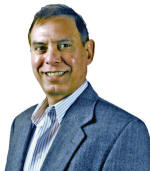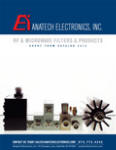|
|
|
|
Anatech Electronics Newsletter - February 2014
|

Anatech Electronics has published its February 2014 newsletter. As always, it includes both
company news and some tidbits about relevant industry events, regulations, and standards. This
month, Sam Benzacar offers his views on the subjects of spectrum sharing, the role of carrier
aggregation in LTE-Advanced systems, and the latest killer app for NFC.
 WHAT’S
NEWS WHAT’S
NEWS
Feds: It’s Tough To Get Agencies to Share Spectrum
The White House is trying to figure out how to get government agencies
to give up their cherished spectrum to commercial users in order to free up the 500 MHz
it has promised for use by wireless broadband. Several proposed ideas include creating a
fund from the proceeds of spectrum auctions to help agencies cover the costs of moving,
charging agencies for their use of spectrum, and allowing them to lease spectrum on a short-term
basis.
Another idea is to create one gigahertz of shared spectrum that could be
used by both commercial and federal government users while also creating a tiered approach
that gives the federal government priority access but also allows licensed commercial organizations
to use it.
The Latest Killer App for NFC: Fear
Near Field
Communications (NFC) is always seemed like it needed a big push to get started, and how
it has one: security. Visa and MasterCard are working feverishly to allow shoppers to pay
at retail stores without pulling out their credit cards. Both companies just announced that
they working with retailers and banks to incorporate better “contact-less” payment systems
into their mobile apps.
In this first round of a rush to NFC it looks like Android
will be the winner as one of its latest features called Host Card Emulation that allows
personal information to be stored in the cloud rather than the phone, which the app then
accesses at the point of sale. The Kit Kat (Version 4.4) of Android offers this feature
in many Android phones have it. The iPhone 5S does not have it. The card number is stored
in encrypted form on the phone and can be disabled remotely if the phone is lost or stolen.
|
The Crucial Role of Carrier Aggregation in LTE-Advanced

By Sam Benzacar
The issue of spectrum fragmentation has long been a thorn in the side of wireless carriers,
as there is no contiguous spectrum available to provide the increased bandwidth required
to deliver the high-speed data communications required for LTE-Advanced.
Fortunately,
the standard itself is solving this problem through carrier aggregation, which allows carriers
to combine a 20 MHz of spectrum with 20 MHz and another and so forth up to five segments.
Collectively they produce a bandwidth of 100 MHz, which is what LTE-Advanced will require
to deliver its blazing theoretical data rate of almost 3.3 Gb/s using 8x8 MIMO.
Much
has been written about carrier aggregation from a technical perspective, but at the “50,000
foot level” the benefits of this technique cannot be overstated. There is obviously no practical
way to reallocate spectrum allocations throughout the world, and no carrier has 100 MHz
of contiguous bandwidth, so without carrier aggregation it’s safe to say that LTE-Advanced
would be extremely difficult if not impossible to achieve.
That’s not to say that
the other technologies required to realize 3GPP Release 10 that delineates LTE-Advanced,
are less important or even trivial as they are neither. Release 10 is enormously complex
and relies on various types and levels of MIMO, beamforming, a new feature called Coordinated
Multipoint (CoMP) that increases performance at cell edges and provides greater support
of heterogeneous networks (that is, macro, pico, and femto cells), along with comprehensive
software, high-speed processing and analog-to-digital and digital-to-analog conversion,
among other things.
However, the ability to combine 20-MHz slices of spectrum whether
near or far away in frequency provides the key to unlocking the performance of LTE-Advanced.
From an RF perspective, implementing this do standard appears to be somewhat less daunting,
requiring changes to transceiver design, as well as modifications to base stations and widespread
use of small cells.
And of course, filters will continue to play a key role in keeping
interference in check, although in some wideband transceiver architectures this filtering
will perform digitally.
In short, carrier aggregation and the other technologies
that will make LTE-Advanced the reality are well along in development. In fact standards
groups are already focusing on Release 11, which rather than increasing data rates promises
to deliver better overall performance.
Proposed enhancements include more streamlined
carrier aggregation and CoMP, a new control channel, better inter-cell interference coordination
and avoidance, reduced power consumption for user devices and the network, support for machine
to machine communications, and other tweaks.
Anatech
Electronics has been solving interference problems in wireless systems since the first cellular
systems appeared, and we can help you solve yours today. So please give us a call at (973)
772-4242 or send us an email to
sales@anatehelectronics.com. |
 We
Can Help You Get Products to Market Faster We
Can Help You Get Products to Market Faster
Too many times, filters are one
of the last things to get specified into a design. It's a hard habit to break, but we can
help.
Anatech has a vast filter design library that covers a broad array of frequencies,
power levels, rejection, packaging, and other parameters in topologies ranging from SAW
to crystal, ceramic, cavity, and lumped element.
So it doesn't take as long to accommodate
even the most demanding performance requirements as well as package configurations, military
screening, and weatherization.
You need filters fast, draw on Anatech's experience.
Call us today at (973) 772-4242, or send us an email by clicking
here.
 Try
Out Our Technical Workbook! Try
Out Our Technical Workbook!
Calculate parameters for bandpass, lowpass,
and highpass filters, as well as attenuators, and directional couplers. This interactive
workbook also covers system cascade parameters, coil and wire inductance, mixer conversion,
radar blind speed, propagation time versus frequency and many other helpful tools. Check
it out!
Download Our Technical Guides

Request a Quote

Download Our Short-Form Catalog

Visit Our Web Store

|
About
Anatech Electronics;
Anatech Electronics, Inc. (AEI) specializes in the design and
manufacture of standard and custom RF and microwave filters and other passive components and
subsystems employed in commercial, industrial, and aerospace and applications. Products are
available from an operating frequency range of 10 kHz to 30 GHz and include cavity, ceramic,
crystal, LC, and surface acoustic wave (SAW), as well as power combiners/dividers, duplexers
and diplexers, directional couplers, terminations, attenuators, circulators, EMI filters, and
lightning arrestors. The company’s custom products and capabilities are available at
www.anatechelectronics.com and
standard products are available for purchase at the Anatech Electronics Web store,
AMCrf.com.
Contact:
Anatech Electronics, Inc.
70 Outwater Lane
Garfield, NJ 07026
(201) 772-4242
sales@anatechelectronics.com
Posted
February 25, 2014
|
|
|
|

 WHAT’S
NEWS
WHAT’S
NEWS 
 We
Can Help You Get Products to Market Faster
We
Can Help You Get Products to Market Faster Try
Out Our Technical Workbook!
Try
Out Our Technical Workbook!


